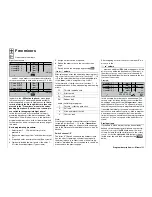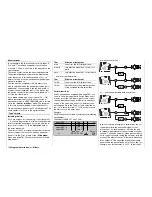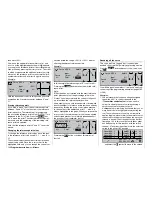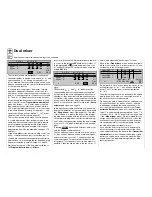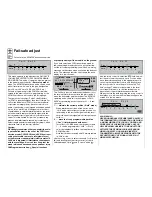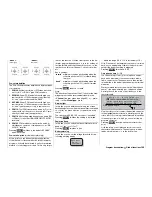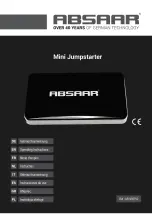
148
Program description:
Special functions
Fail-safe adjust
Fail-safe in the “SPCM20” transmission mode
F A I L S A F E
Pos
hold
1
2
3
4
5
6
7
8
This menu appears in the multi-function list ONLY IF
YOU HAVE SELECTED THE SPCM20 TRANSMIS-
SION MODE. This mode of operation must be pre-set
in the model memory specifi c »
Base setup model
«
menu. The SPCM20 transmission mode can be used
with all receivers with “smc” in the type designation
(smc-19, smc-20, smc-19 DS, smc-20 DS, etc.).
Fail-safe programming for the PCM20 mode is dis-
cussed in the previous section; programming for the
APCM24 mode can be found on the facing page.
The operational security of Pulse Code Modulati-
on (PCM) is inherently higher than that of simple Pul-
se Position Modulation (PPM), since the receiver in-
corporates an integral micro-processor which is ca-
pable of processing control signals even when picked
up in a “dirty” state. Only if the signals are incorrect
or garbled due to outside interference does the recei-
ver automatically replace the invalid signal with the
last received correct signal, which is stored in the re-
ceiver. This time-limited “hold-mode” procedure sup-
presses brief interference caused by local drops in
fi eld strength and similar momentary problems, which
otherwise result in the familiar “glitches”.
Caution:
We strongly recommend that you exploit the safe-
ty potential inherent in the use of the PCM trans-
mission modes PCM, SPCM and APCM by at least
setting the throttle to move to idle (glow motor)
or the motor to stop completely (electric motor) if
Fail-Safe is triggered. If interference should occur
with these settings, it is much less likely that the
model will wreak havoc and cause personal injury
or property damage if the model is on the ground.
If you have selected a PCM transmission mode for
the current model memory but have not yet carried
out the fail-safe programming, you will see a warning
message on the screen when you switch the transmit-
ter on. The message remains on-screen in the basic
display for a few seconds:
Model name
#01 0:37h SPCM20
H-J.Sandbrunner
9.5V
2:52h C62
0
0
0
0
S
F
0 00
0 00
:
:
F a i l S a f e
s e t u p
t . b . d .
The “Fail Safe” function determines the behaviour of
the receiver if interference affects the radio link bet-
ween the transmitter and the receiver. The SPCM20
operating mode offers two optional types of “FAIL-
SAFE” programming; each of the servos 1 … 8 can
optionally …
1. … maintain the current position (“Hold” mode)
When interference strikes, all the servos set to
“Hold” mode stay continuously at the position cor-
responding to the last valid signal, until the recei-
ver picks up another signal which it recognises as
valid; or …
2. … move to a freely programmable position
(“Pos”) if interference should occur.
In contrast to PCM20 mode, the receiver outputs
1 … 8 can be programmed to “Hold” or “Positi-
on” mode individually (without a pre-set delay) in
SPCM20 mode.
Note that receiver outputs 9 and 10 always remain
in “Hold” mode.
Use the rotary control to select channels 1 to 8 in turn
(
), and briefl y press the rotary control in order to
switch between “Hold” ( ) and “Position” mode ( ):
Pos
hold
1
2
3
4
5
6
7
8
STO
F A I L S A F E
Use the rotary control to select the
STO
fi eld. Now se-
lect the servos which you have set to Position mode,
move them
simultaneously
to the appropriate positi-
ons using the transmitter controls, and briefl y press
the rotary control to store the positions as the “Fail-
Safe” settings. This data is transmitted to the recei-
ver at regular intervals, so that the receiver can al-
ways revert to them if interference should strike.
When you store the data by giving the rotary control a
brief press, you will see the following message on the
screen for a few moments:
Pos
hold
1
2
3
4
5
6
7
8
STO
Position stored
F A I L S A F E
W A R N I N G:
NEVER, UNDER ANY CIRCUMSTANCES, SWITCH
THE TRANSMITTER OFF WHEN YOU ARE FLYING
A MODEL AIRCRAFT! IF YOU DO, YOU RUN A SE-
RIOUS RISK OF LOSING THE MODEL, AS YOU
WILL BE HIGHLY UNLIKELY TO BE ABLE TO RE-
ACTIVATE THE RF SIGNAL QUICKLY ENOUGH
WHEN YOU SWITCH ON AGAIN, SINCE THE
TRANSMITTER ALWAYS RESPONDS WITH THE
SECURITY QUERY “RF SIGNAL ON YES / NO”
WHEN SWITCHED ON.
148
Summary of Contents for mx-24s
Page 1: ...1...
Page 19: ...19 For your notes...
Page 35: ...35 For your notes...
Page 41: ...41 41 For your notes...
Page 57: ...57 For your notes...
Page 63: ...63 63 For your notes...
Page 69: ...69 69 For your notes...
Page 85: ...85 85 For your notes...
Page 99: ...99 For your notes...
Page 143: ...143 For your notes...
Page 191: ...191 For your notes...
Page 212: ...212 212 For your notes...
Page 213: ...213 213 For your notes...
Page 214: ...214 For your notes...
Page 216: ...216...


